Text
10 top free resources for teaching physics to kids
Imperial College physics student Catherine shares the best online resources for learning about physics:
The Institute of Physics and is great for learning about lots of aspects of physics. I especially like the teaching astronomy section which has lots of fantastic videos aimed at 11-16 year olds. Physics tutors are often asked: “how can I get my son/daughter excited about science?” I say start here! These videos are are great for grabbing kids' imaginations.
The Physics classroom covers a lot of key physics material syllabus that is certain to come up in exams. I particularly like the introduction into waves. More advanced students have plenty of scope to learn too, which is perfect for continuing their interest. Good to note that it is also available on iBook and iPad.
Top Marks is a resource for 9 to 11-year-olds and perfect for help with the 11 plus. The site is designed with fun colourful games to engage kids in learning about science and enable a continued interest in the subject. I have linked a game that teaches about solids, liquids and gases but you can search the site for other interactive games.
My Physics is a fantastic GCSE physics site that goes through each topic for Physics GCSE revision. It’s highly interactive, colourful and easy to use. I'm excited about the promised A-level section - coming soon!
Purely GCSE revision with past papers and resources to look up when you are stuck, GCSE.com makes sure you have covered everything. Their very simple diagrams that provide a new way at looking at topics, which may be more intuitive for your child.
I love the website school physics for its fabulous animations to illustrate key physics ideas. There is an extensive number of them and they are all very simple and easy to use.
Discovery Education is great for tutors and teachers as it has full lesson plans for different topics. Well worth a look through if you find yourself getting stuck on how to approach a topic.
The Science Museum is not only a great museum (that happens to be next to Imperial,) but also an inspiring online resource. There is a comprehensive section on climate change and policy. If it grabs the kids', and your, attention why not turn the online learning into a day out and visit the museum. It's free!
My list would not be complete without mentioning the wonderful Khan Academy. It was started by Khan uploading videos to Youtube as a means to teach his niece, who lived far away. Before too long his videos had gone viral and if you take a peak at the physics videos, you'll see why.
Now that we have caught the kids' attention... Let your child get stuck into these MIT University online courses and the sky is the limit. Happy learning!
1 note
·
View note
Text
Beat the Summer Slide!
Summer Slide; what’s that, then? The latest playground instalment, perhaps? A new water park feature? Sounds fun; somewhere the little ones (and bigger ones) can entertain themselves and burn off some of that energy when you’re wondering what on earth to do with them now and counting down the days until term starts again…

Unfortunately, the Summer Slide is none of these things. It’s a term coined by educational psychologist Harris Cooper, who found that US schoolchildren regress in all subjects over the summer holidays, by an average of a month – a whopping 2.6 months in maths.
Many will protest that the kids need a bit of R&R just now (especially if you’ve just gone through the agony of June exams). But for those experiencing a tremor of despair at the thought of all that algebra, so painfully installed in the offspring’s head, just trickling out again like sand from a leaky bucket: here are some tips for parents and tutors, to retain some learning over the summer.
1. Play not work
Summer learning should be fun. Whether you’re educating your children yourself, or enlisting the help of a nanny or tutor, take the lessons outside the classroom and discover activities that your child will enjoy. Find out about next year’s curriculum; just hearing about a topic in advance helps pupils to learn it quickly in the classroom. Create a treasure hunt with subject-specific clues – this has the added advantage of keeping them occupied for some time, depending on how tricky the questions are.
2. Riveting Reading
Cooper found that the poorest children lose the most reading skills, while those better off actually improved over the summer. The long summer break can be an opportunity for children to discover reading. Be inventive; even the most reluctant reader just need the right trigger.
For the tech-savvy paper-phobic child: I know a mother who bought a £30 Kobo from WHSmith, as a last-ditch attempt to get her 10-year-old reading. The child was instantly engrossed, constantly pestering her for more and more and more ebooks. The Kobo is now adorned all over with stickers, and the young girl’s prize possession. You could try the Summer Reading Challenge, which rewards children with stickers and certificates, or the Reading Chest – lovefilm for books, from under £10/month for up to 6 books a month.

3. Marvellous Maths
-Adapt recipe quantities while cooking to familiarise children with dividing, multiplying and using fractions. These questions crop up everywhere from primary school to GCSE Maths.
-Next time you’re begged for a trip to Thorpe Park, ask your child to calculate the cost for the whole family. For the cash-strapped parent, this might have benefits beyond maths practice!
-When your 6-year-old asks, again, how long till his best friend arrives: ask him to work out the time in hours and minutes (or days and hours, depending on how early the excitement starts to build…) Young children find time calculations a challenge, counting in a base of 60 instead of the normal 10s and 100s.
-Children are natural entrepreneurs: if it would be safe and you can keep an eye on them, a home-made lemonade stall requires plenty of maths practice. Just keep an eye on the recipe to make sure they produce something drinkable! Ask them to calculate the profit margin and hourly earnings - useful to know when employing a younger sibling…

-Puzzles like Kakuro and Calcudoku are a god-send to get children doing the four main operations (+, -, x, ÷) really quickly. It’s amazing how much even teenagers can benefit!
4. Whirlwind Writing
-Long car journey? As a pre-teen with 3 younger siblings, I had a whole series of car-time tales about Ruthy the rat who rode the tube around London with her ratty friends. Kill two birds with one stone: encouraging your children to pass the time telling stories develops their linguistic creativity as well as stopping them from pinching each other, kicking your seat and dropping banana skins down the driver’s neck (yes, I’m afraid we were that awfu). You can offer a prize for the best story.
-Sign up to Creative Writing 4 Kids (£4.99/month, first month free) where children write their own online book for themselves and their friends.
-Postcards are a cheap, appealing way of getting a child to pen a few lines to a friend.
5. Super Science
-Normally forbidden, night-time activities have a special thrill. Take your child outside on the 26th July to see the next New Moon (if you miss that one, you could start with the full moon on 10th August). Repeat every 7 days to see the whole cycle - or go more often to observe the gibbous and crescent moons. Check the moon phases and rising times. This summer's full moons are perigee moons, so they will be even brighter!

-Take advantage of the British summer weather: after the next rain shower, draw chalk circles round a few puddles, to observe the water cycle. Even in our damp conditions, your child will see evaporation in action as the puddle shrinks.
-In the garden or park, ask your child to collect small (one leaf is good) samples from different plant species. Go over these samples together, discussing differences and similarities, and why one plant is classed as a different species from another.
6. Ghastly guilt-trips (for working parents)
If you’re reading all this wondering how on earth you could abandon your precious children for upwards of 8hrs a day, when clearly you should be at home educating them… Don’t beat yourself up. Children are remarkably good at learning in different environments with different people, and if you can afford some extra help, a tutor could be just what they need to inject some educational fun into the holidays. This doesn’t mean someone who will sit at home forcing algebra over the kitchen table! Most tutors are, by now, as fed up of painful exam-cramming as you and your children, and will be only too happy to rediscover the joy of learning over summer. If a tutor’s rate seems a bit steep for taking your children to the Science Museum all day, don’t be afraid to ask (politely!) about a possible discount; this is the tutor’s quietest time of year, and the work is much more enjoyable than chemistry cramming.
Some families even take a tutor away on holiday with them. While this will add considerably to the holiday’s price tag, it can be a fantastic way to keep up your childrens’ learning and physical activity, while you get to recover and relax over a cocktail… The usual arrangement is to cover all expenses and pay a rate equivalent to 4 hours a day, with additional payment if more teaching hours are required; but if the tutor has no other work on and you mostly want educational fun rather than formal lessons, you may be able to drive a bargain.
Check out some of our best-value tutors for the summer:
Egypt James N Mathilde



Joe L Carmela Sam W



0 notes
Text
How to prepare for the 11+ exam
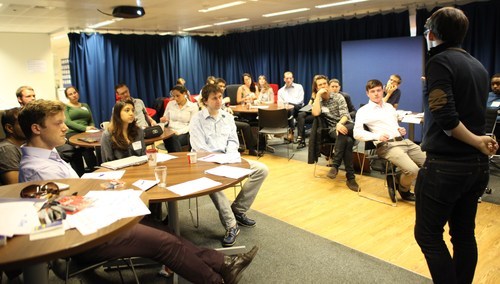
20 of London's top tutors got together today to pool their knowledge of the 11+ entrance exams. Which are the top schools, how do they test maths and English, what are parents and students asking and how can tutors help students prepare?
Above shows Mark Maclaine doing a concise 20minutes on the psychology of how students learn. He explained presence, the zone of proximal development and other key concepts in ways everyone could go on to explain to their tutees. "One of the great ways to unlock learning is to help someone understand how they learn." Mark
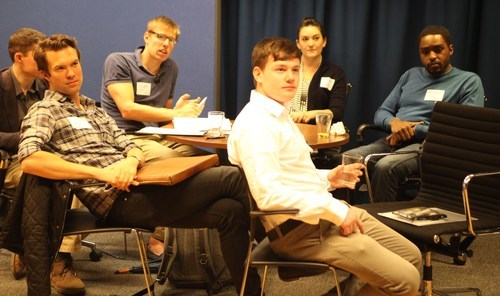
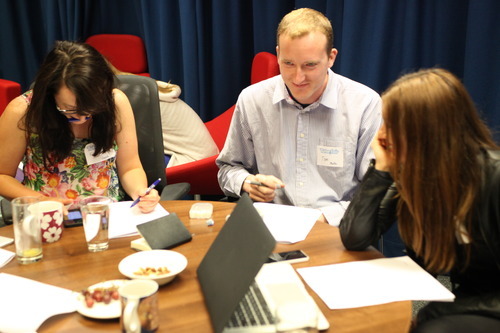
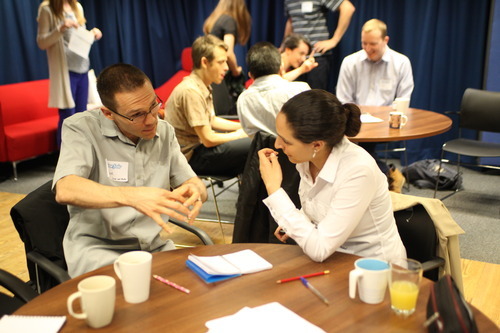
"Totally eye-opening experience, I've been tutoring for 10 years and I learnt more about the 11+ exam today than I ever knew before." - Joe
"Great day! Thanks a lot!!!" - Ria
"Interesting and rewarding. More of these in the future please." - Atul
Watch out for blogs to follow on the many 11+ tips and hints that have come out of today!
Many thanks to these tutors for their support and feedback:
Madeleine K
Phineas P
James R
Frank I
Raphael O
Sawan S
Samantha S
Stuart M
Joe N
Felicity D
Ria T
Atul R
William R
Tony D
Melanie A
Alex L
Matthew S
Tom L
Radha S
Alexis S
John N
Lia T
0 notes
Text
Tutor Stories: Jose volunteering at Pimlico
Tutorfair's vision is that for every student who pays, we give tutoring to children who can't afford it. Some of our tutors deliver this life changing tuition in inner-city schools. You can read about their stories here.
I started helping as a volunteer assistant in Pimlico Academy three weeks ago and the experience cannot have been more exciting and engaging.
As a teacher looking for experience in the UK system I completely enjoyed the open collaboration among the teachers of the Modern Foreign Languages Department. I really appreciated their diverse experience with students and their abilities to manage different profiles.
Helping students to prepare to their final exams has been one of the most interesting experiences I have ever done in my career. There were hard days and hard hours; it was never an easy task to help students to develop in a different language that it will help them in the future to find a job; but it was enjoyable. Motivation is always the teachers ́ task. I learned that in Pimlico. It is in our hands to help students to be better, to support them to face the world.

To view Jose's profile, please follow this link
0 notes
Text
Science Box - The wonders of the rainforest for 11-14 year olds
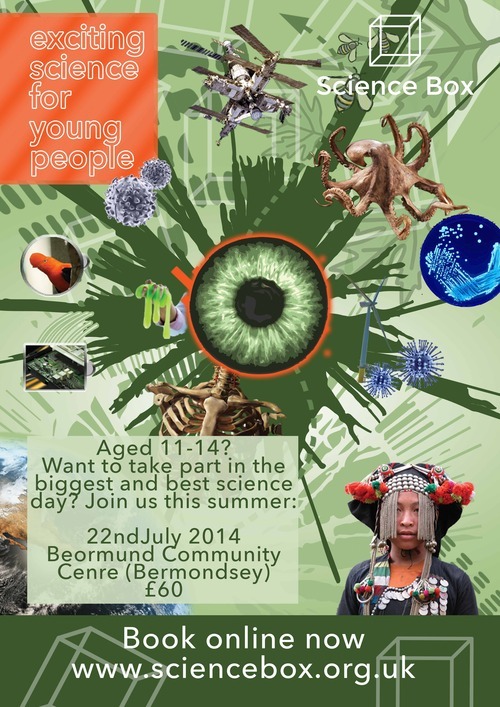
Tutorfair are very proud to announce they are sponsoring Science Box – a series of interactive science-based workshops for 11-14 year olds in London. Bookings are now open for Science Box's two forthcoming 'Rainforest Uncovered' events in the capital, which take place on 21st July at the Dunraven School in Lambeth, and 22nd July at Beormund Community Centre in Southwark.
Having recently returned from a trip to the Peruvian Amazon, the founder Deepesh Patel, has become intent on demonstrating to young children across the country that science, in reality, goes far beyond laboratories, formulae and, as he puts it, “wearing white lab coats”. Despite having travelled to one of Earth's most diverse ecosystems, he suggests that it was actually when a young pupil from County Durham told him how he had inspired her to pursue sciences onto further education at college which gave him the motivation to set about executing the project.
'Rainforest Uncovered' will take place on two dates in July in South London, and both events look set to be packed full of interactive, informative and fun-filled science-based workshops. Delivered by an assortment of some of the most engaging and effective science communicators in the UK, the days will consist of a variety of different activities. These will range from extracting chemicals from rainforest plants to test for their medicinal properties, through debating the likely fate of the Amazon's native peoples, to making synthetic rubber out of household items and establishing the eating patterns of live crickets. Whilst fun, these activities will provide ample problem-solving opportunities for the pupils, and will aim to challenge their established ideas and perspectives throughout the day.
Details are as follows:
Age: 11-14 years (year 7-9)
Venue: Dunraven School, Streatham (21st July)
or Beormund Community Centre, Bermondsey (22nd July)
Time: 9:30 - 16:30
Light refreshments provided (not lunch)
Cost: £45 for Tutor Fair members (£60 normally)
Discount Code: TUTORFAIR15
To find out more about Science Box, to book onto one of their forthcoming events, or to enquire about staff and relevant qualifications, head to their website: www.sciencebox.org.uk. Alternatively you can phone Science Box on 0203 239 4036 or email them using [email protected].
0 notes
Text
Exam Day Hints

Exam time is here but there’s no need to panic! Our tutors have shared their best exam day tips to get you through this scary time. From everyone at Tutorfair: GOOD LUCK!
1. The night before: go to bed half an hour earlier than usual to wind yourself down ready for a good night’s sleep.
2. In the morning: eat a high protein and complex carbohydrate breakfast. It will release energy slowly through the day, keeping you alert for your exam.
3. Write a list of anything you wish to take with you to the exam in advance. Forgetting even a small thing, such a pre-exam snack, could throw you off course and add to feelings of nerves.
4. Arrive early to your exam venue and don’t speak about the exam topics with your peers. Last -minute discussions about which topics everyone has focused on won’t help and may panic you.
5. Accept those butterflies in your stomach before the exam! Those feelings of nerves are increasing your heart rate, delivering more oxygen to your brain and keeping you alert.
6. When the examiner announces the start there will be a frantic rustling of papers. Don’t dive in with everyone else: wait for the commotion to die down and then calmly turn over your paper. When you see the questions for the first time, you’ll be quiet and focused instead of panicky.
7. Once you've warmed up your brain with a few of the easier questions, consider going to the end of the paper and working backwards. Doing the harder questions first, when your brain is fresher, may result in fewer careless mistakes.
8. An old but important favourite: check how many marks are assigned to each question and spend your time accordingly! If it’s a 60-minute exam with 60 marks, you can spend 1 minute on each mark.
9. Jot down any vital equations, facts, quotes or dates at the start while your brain is fresh. As you get more tired you can refer back to them. Anything that takes less than a minute to put down is worth it. Don’t spend too much time though – they might not come up.
10. Don’t waste your energy and confidence on a question that feels insurmountable. Circle it and come back to it later. You might figure it out while filling in the rest of your paper; or a later question may even remind you of the answer.
2 notes
·
View notes
Text
What's stopping your students transitioning from 75% to 90%?

Sithan K, Specialist Maths Tutor
Sithan shares his secret with Tutorfair about how to help maths students avoid ‘silly mistakes’.
Does this sound familiar to you?
“I don't know why I keep making these stupid mistakes in maths. I never get over 90% on practice tests even on problems I am good at because of these mistakes.”
In the past, whenever I heard something like this, I usually dismissed it to focus on “more pressing matters” like helping with Trigonometric Identities.
Boy…….was I WRONG!
It wasn’t until the same problem occurred over and over again that I decided that this might be a bigger issue than most people think.
Careless mistakes account for a huge number of lost marks in maths, where one mistake - doing a plus instead of multiply, for instance, or putting the decimal point in the wrong place - can lose all the marks in a question. These careless errors stem from the inability of the mind to concentrate. But how can we to avoid them?
SHUV Strategy
Slow down . Hang On a Minute. Underline Stuff . Visualize with Vivid Images.
1. Slow down
Practicing the skill of slowing down is quite challenging, especially in exam conditions where students know they have a limited amount of time. Ask your pupil to say this sentence before every question:
“I am just going to slow down for a bit here”.
Repeating this sentence exactly sends a signal to your brain to slow down and start thinking.
2. Hang On a Minute
Besides slowing down, engaging your student’s curiosity reduces the chances of careless mistakes. Repeat the sentence:
“Hang on a Minute, something sounds fishy”
Even when the student doesn’t feel that way, this will help to shut off automatic guessing mechanisms.
3. Underline Stuff
Besides the obvious benefit of underlining key points from questions, following the question with a pen fixes your gaze to one word at a time and reduces the ‘scatter brain’ syndrome where your mind just tries to look everywhere.
(see spreeder.com for fun examples of this)
4. Visualize with Vivid Images
Daydreaming can be controlled by deliberately trying to visualise an image or picture that is partially relevant to the question. Whenever the student sees a question on gradients, he or she can visualise a playground with a slide and the formula of the function floating around this playground. The more strange the context the better.
Finally, we need to understand that paying attention to detail is an art form that has to be practiced!
Sithan obtained 4 A-stars in his Edexcel A-Level exams (narrowly missing the world award for Mathematics and Further Mathematics) and graduated with a first class degree in Electrical Engineering from Imperial College London. Sithan is currently pursuing a PhD in Machine Learning at Imperial College and aspires to become a full-time teacher in 2 years.
1 note
·
View note
Text
Public School Admission Interview Questions Revealed
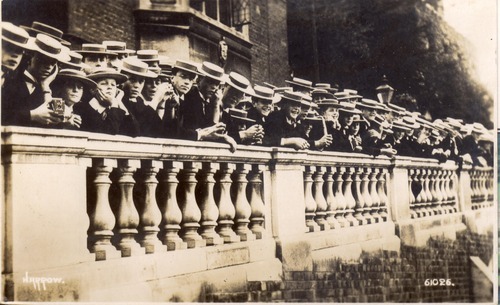
Being a tutoring company with some of Britain's best educators we have got our hands on the tutor's holy grail - a certain, very exclusive school's interview questions for 13+. We have anonymised them but know they will be very helpful with interview season almost upon us.
Enjoy.
1.Why do you want to go to a single sex/ co-ed school?
2.Why do you want to go to a boarding school?
3.Why do you want to come to this school?
4/ 5.What is/ are your favourite sports?
6.What is/ are your favourite subjects?
7.What is the last book you read?
8.How many sibling(s) do have?
9.What are your other interests?
10.What do you dislike the most?
11.Do you enjoy travelling? and which countries have you recently visited - what can you tell us about your favourite places of interest
12.Who is the PM of England?
13.What recent news has disturbed you the most?
14.Do you know any boy(s) who have been to this school or currently here with us?
15.Where do you live?
16.What do your parents do for a living?
17.What would you like to do when you grow up?
18.How far is your house to this school?- how have you travelled here today?
19.What is your worst subject(s) at school?
20. How tall are you and how much do you weigh?
21.Tell us/me a bit about yourself? or Give us three words that your friends would use to describe you.
22. What other schools have your parents applied to for you - or you would like to go if we do not offer you a place here?
23. Did your parents or anyone prepare or tutor you for today’s interview?
If you need the help of a tutor for school admissions search on Tutorfair. Here are a few examples of our specialist admission tutors.



Joseph N - Specialist in Westminster Admissions
Phineas P - Specialist tutor in Eton Admissions
Alexis S - Specialist in Harrow Admissions
0 notes
Text
GCSE History Revision - The February/March Russian Revolution - The impact of the First World War

Twentieth century Russia is a modern world depth study offered for GCSE History with all three exam boards, AQA, OCR and Edexcel, so here are some revision notes to help explain that all-important Russian Revolution. It’s a good time to look at the impact of the First World War too, with the centenary being marked this year.
The March Revolution (also known as the February Revolution) in 1917 resulted in the end of the Romanov Dynasty in Russia. But why did this happen? Historians love to have a good debate so ‘how far the impact of the First World War contributed to the revolution’ is often discussed. As you discover more and more about this topic, you might develop your own opinion on too. So, what actually happened to Russia during the war?
The Military
The Russian army was not a great one. Although Russia had the largest army out of all of the countries in the war, in proportion to its population it was just half the size of the army of France and Germany. The Russian army was also not well equipped, as 6.5 million troops only had 4.6 million rifles - bit of a problem there! No surprise then, that in 1914-15, the army experienced large defeats and, by 1915, 4 million Russians had been killed, wounded or captured. As you can imagine, the people of Russia were getting very dissatisfied. So, in 1915, Tsar Nicholas II decided to go to the frontline and become Commander-in-Chief of the army. However, this then meant that the Tsar was directly responsible for the army and consequently, any failures of the Russian military would be associated with his failure as a leader. Not a great move by Nicholas! By 1916, fewer and fewer troops were willing to fight at the front and over half of the soldiers stayed in the urban barracks. Nicholas was losing the support of his troops as well as his people as they gradually blamed him more and more for Russia’s failures.

Difficult Living Conditions
Living conditions in the large cities during the war were awful, especially in Petrograd and Moscow. There was a huge shortage of supplies. Food and fuel were very hard to come by, especially as the railway had virtually collapsed by 1917 - leaving food supplies rotting in stranded carriages. Moreover, hundreds of factories had closed during the war, leaving thousands of people unemployed. Gold standard was abandoned and more and more notes were put in circulation causing severe inflation! The costs of food and fuel quadrupled (even though there was hardly any available) and savings were virtually wiped out. The urban population was cold, hungry and out of work and people became very angry towards the Russian government.
Alexandra and Rasputin


With the Tsar fighting the war at the front, his wife Alexandra was left in charge, with a monk called Rasputin. They made a mess of the government as they kept changing ministers, replacing good ministers for their own friends. Between August 1915 and February 1917, 36 ministers were changed: not good for the country’s stability! It didn’t help that in a war fighting against the Germans, Nicholas’ wife was herself German. Alexandra and Rasputin were made a mockery of and it ultimately discredited the Tsar’s leadership - the Russian people were becoming less and less willing to support him.
No political reform
As Nicholas II was busy with the war, it was a good opportunity to allow some political reform. The Duma era came as a result of the 1905 Revolution but this was often criticised for being a ‘Rubberstamp democracy’. The Duma was the lower house of the Russian parliament but due to the Fundamental Laws issued in April 1906 it had very limited powers. The Duma therefore called for concessions during the war but the Tsar rejected their appeals, which led to the creation of the Progressive Bloc (made up of two thirds of Duma members) who wished to form a Duma-based government and basically run the country for Nicholas. But Nicholas wanted to keep his autocratic power and rejected these ideas too. Yet, as the Tsar showed himself to be increasingly incapable of running the war and country, the Progressive Bloc became a focal point of resistance - leading the Russian people to take matters into their own hands.
Big events followed. See below to view the timeline. (The dates are according to the old style Julian calendar -13 days behind the rest of Europe)
25th February - General Strike - troops were beginning to side with demonstrators. Policeman is shot by a cossack (soldier).
27th February - Unofficial meeting of the Duma, who taking control of Russia away from the Tasr.
28th February - Tsar Nicholas II attempts to return to Petrograd but is prevented from doing so by his own troops. Now he’d lost the support of the army and the Duma!
2nd March - Provisional Government formed out of Duma Committee. Nicholas signs Decree of Abdication for himself and on behalf of his son, Alexei.
3rd March - New government publicly declared.
4th March - Formal declaration of the abdication of the Tsar and the end to the Romanov dynasty after 300 years! Bye bye Nicholas!
That was by no means the end of Russia’s problems though; the mayhem continued and in October 1917 the Bolsheviks took over in a second revolution.
So how far was the First World War to blame for the March/February Revolution? Was it the main cause or was it just the trigger to a revolution that had been long-due because of the failures of autocracy? You decide!
If you fancy having some more help with your History revision, then why not visit the Tutorfair website and find the right tutor for you. Here’s a small sample of some of History tutors:



Hubert M - Kind-hearted tutor, BA Oxon, MA London
Phineas P - Experienced tutor who gets great results
Aren R - Inspiring, enthusiastic, knowledgeable PhD student
Images from commons.wikimedia.org CC-by, en.wikipedia.org CC-by and sv.wikipedia.org CC-by
#edexcel history gcse#history revision gcse#ocr history gcse#aqa history gcse#1917 russian revolution#1917 russian revolution timeline#causes of the russian revolution#history tutors#history tutor london
1 note
·
View note
Text
Desmond T: Maths, Science and Chess tutor in London

Desmond T is a maths and science tutor teaching from 11+ up to A Levels. He has tutored for over seven years now - and over 90% of his students have gone on to achieve A or A* at GCSE/A-Level! He is a graduate in Civil Engineering from Imperial College London whilst being an awesome chess player. Desmond represented England at the World under 12 Youth Chess Championships in Brazil and won the under 18 British Chess Championships at the age of 15.
Why do you love tutoring?
Ever since I started tutoring, it has become a passion of mine as it gives me great pleasure in helping others achieve their goals, no matter what they are. It is always challenging for someone to learn something new, whether you are a young child or maturing teenager, but at the same time it is satisfying when it suddenly "clicks".
Who inspired you in education?
My old chess coach helped me find a new way of learning whilst having fun. While preparing for some major chess tournaments, and with quite a lot of parental pressure, he was always able to bring the best out in me by keeping me relaxed through patience; a trait that I have tried to inherit.

What else do you get up to besides tutoring?
At the moment, due to workload, not a lot! But I have a passion for travelling and eating out; there is nothing better to the end of the day than eating a nice meal out!
If you had a super power what would it be?
Hmmmm, not sure, never really thought about this.....I suppose to travel at the speed of light because it would help me cut out the travelling time when teaching!
What advice would you give to a parent on how to find a tutor?
This is a very interesting question. It is important to understand what the tutor can offer and whether there is synergy between tutor and pupil. I believe that only in a relaxed environment can the child excel. There is nothing wrong about having a couple of trial lessons to see if they can build up that relationship.
Want to meet Desmond? See below to view his short video:
Subjects taught by Desmond:
Maths- IB, A-Level, GCSE, Common Entrance, 11+
Biology - GCSE
Chemistry- GCSE
Physics-GCSE
General Science-Common Entrance, 11+
Chess
If you or your child needs help with maths, science or chess then please click here to view Desmond's personal profile on the Tutorfair website and book a lesson.
Image from en.wikipedia.org CC-by
#meet a tutor#maths tutor#personal tutor#private tutor#greater london#home tutoring#science tutor#maths help#maths revision#maths help for kids#science help#homework help#how to play chess#chess tutor
1 note
·
View note
Text
Tutorfair in National Science and Engineering Week

Tutorfair has been very excited to take part in National Science and Engineering week. It has prompted us to reflect on the importance of STEM (science, technology, engineering and maths) in the modern world.
Forty years ago, there were no mobile phones in sight, yet now they are everywhere and most people own one. We live in a world with groovy gadgets, transport to almost anywhere and medical advances finding more and more treatments for life-threatening diseases. All of these would not be around without science, maths, technology and engineering. These subjects enable innovation that is crucial for the future!
Yet, as our tutors have discovered, science and maths are subjects which children often struggle with at school. Of all subjects, tutors are required the most for maths and science. Why is that? Perhaps it has something to do with Dr Carol Dweck’s concept of a fixed mindset where people believe that traits and talents come naturally rather than being cultivated over time (a growth mindset). The phrase ‘I’m not a maths person’ often pops up because it provides this sense of relief to students and almost gives them permission not to try because they are bound to fail anyway. This is what a tutor tries to overcome. Tutors provide students with the confidence to cultivate a love of learning to show that actually, when a student puts in the effort, great achievements are possible!
A tutor can also explain the connections showing how these subjects can be applied to the real world. That’s why, in celebration of National Science and Engineering week, we have held three events named ‘STEM Special Meet and Greet’ to encourage more enthusiasts in STEM subjects to become tutors. These great people realise how powerful STEM is in education and are keen to pass on their enthusiasm to others.

So why do they love STEM?
Tim, a physics undergraduate, loves science because “it’s amazing to understand why and how things happen in the world we live.”
Aastha, a postgraduate studying dentistry surgery, added that science is fantastic because “it’s made up of logic and is happening all around you”.
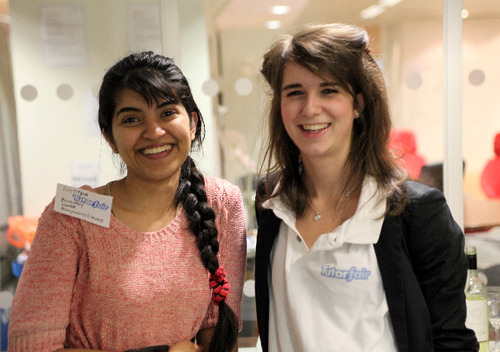
And Jasmine, a maths undergraduate, made us all laugh with her pragmatism: “without maths, how would you calculate discounts? It’s vital for shopping!”
Junas, a science teacher added this thoughtful remark: maths is “a universal language. Wherever you go 2+2 will have the same answer.”
Junas also runs a STEM after school club for year 8 pupils to help inspire curiosity in these subjects. The sessions link STEM subjects together to show students the bigger picture. Junas loves running these sessions because they have “an impact on students’ actions in life and make them independent.”
We also went to an Edtech Investor Speed-Date (in association with NESTA, EdMix and Emerge) giving technological innovators the opportunity to pitch their ideas for improving STEM education to industry experts and investors. One particularly inspiring company was Itis3d which provides 3D printing workshops in schools.
We held two Careers and Pathways Workshops for sixth-formers at a London Secondary School, bringing in speakers in the medical and engineering professions to explain why they chose their career and how they got there.
Moreover, we were very lucky on Tuesday to have a special treat visit from the expert maths and science author Simon Singh, who shared his vision to inspire young people in STEM. See our interview with him here to find out more. We’ve certainly had a Eureka week!
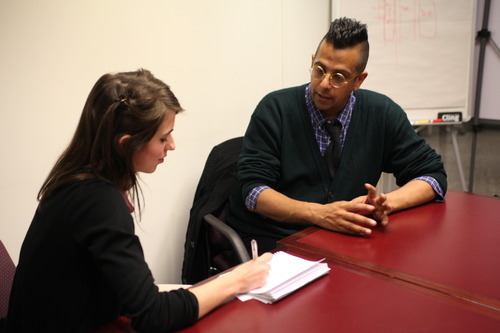
We need to excite the future generation about science, maths, technology and engineering; these subjects are fun as well as importnt! Professionals in STEM careers can transform the world – solving complex problems of today such as climate change, world hunger and inter-dependent world economy! STEM inspires innovation and this is why it is imperative to enthuse the young generation about its importance and its relevance to our everyday lives.
If you or your child needs help with any of the STEM subjects then please visit the Tutorfair website and book a tutor to come to your house.



Frank I - Passionate about science with over 2,599 hours of experience. Subjects include Biology, Chemistry, and Physics
Tasmin B - Passionate about her subjects and loves sharing that with her students. Subjects include Maths and Chemistry
Tony D - Experienced tutor creates an appetite for learning. Subjects include Maths, Science and Computing
#home tutoring#greater london tutors#meet a tutor#private tutor#personal tutors#greater london#homework help#science tutor#maths tutor#maths revision#science and maths tutors#engineering jobs#future technology#technology jobs#maths#science#biology#chemistry#physics
0 notes
Text
GCSE Poetry Analysis Carol Anne Duffy’s – Medusa

Today is World Poetry Day, a day to appreciate and support poetry around the world. In aid of this, we thought we’d give a small analysis on a poem from the AQA GCSE English Anthology: Medusa from poet laureate Carol Anne Duffy’s collection of poems, ‘The World’s Wife’.
The World’s Wife was published in 1999 and presents the female perspective on stories where the male character has traditionally taken centre stage.
So who actually is Medusa?
The character Medusa is one of the Gorgons’ three sisters from Greek mythology, who had snakes for hair and whose gaze turned people to stone. Medusa has always been famous - but Duffy tells her story so that the reader gains some sympathy for this otherwise monstrous character.
The poem
A suspicion, a doubt, a jealousy
grew in my mind,
which turned the hairs on my head to filthy snakes
as though my thoughts
hissed and spat on my scalp.
My bride’s breath soured, stank
in the grey bags of my lungs.
I’m foul mouthed now, foul tongued,
yellow fanged.
There are bullet tears in my eyes.
Are you terrified?
Be terrified.
It’s you I love,
perfect man, Greek God, my own;
but I know you’ll go, betray me, stray
from home.
So better by for me if you were stone.
I glanced at a buzzing bee,
a dull grey pebble fell
to the ground.
I glanced at a singing bird,
a handful of dusty gravel
spattered down.
I looked at a ginger cat,
a housebrick
shattered a bowl of milk.
I looked at a snuffling pig,
a boulder rolled
in a heap of shit.
I stared in the mirror.
Love gone bad
showed me a Gorgon.
I stared at a dragon.
Fire spewed
from the mouth of a mountain.
And here you come
with a shield for a heart
and a sword for a tongue
and your girls, your girls.
Wasn’t I beautiful
Wasn’t I fragrant and young?
Look at me now.
Overview
Medusa is told in the first person as a dramatic monologue by a woman who is insecure and worried that her husband is cheating on her. The poem begins: ‘A suspicion, a doubt, a jealousy’ and it is this jealousy which has turned the woman into a gorgon and now everything she looks at turns to stone. This feeling of doubt resonates throughout the poem, exemplified in the line, ‘but I know you’ll go, betray me, stray from home’.
Unlike our feelings towards the traditional monstrous character, this poem evokes empathy for the character as she is clearly distressed and suffering. Especially when she reminisces in the final stanza about the time she was young and beautiful, illustrating her complete lack of confidence. Nevertheless, she is still presented as a foul character who threatens the reader, with the line ‘Be terrified’. The poem also ends with the line ‘Look at me now’ which has a double entendre (double meaning). It could be read as a cry of despair or, as a threat – if you did look at Medusa you would die! This leaves the reader feeling conflicting emotions for the character, probably similar to how Medusa herself feels in the poem.
Form and Structure
The poem is written in free verse and as it progresses, the importance of the living things Medusa turns to stone increases, going from a bee to a dragon and then to her husband himself. The poem is divided into stanzas of mainly equal length, apart from the final line: ‘Look at me now’. This gives the poem a dramatic ending, leaving the reader unsure whether to feel threatened by or feel sorry for Medusa.
Language
The poem is packed full of rhyme (including half rhymes, internal rhymes and in stanzas 3, 4, 5 and 6 some end rhyme). This rhyme helps to unify the lines and create a sense of rhythm. The end rhyme produces a sense of finality connected with the death of her victims.
Sibilance is particularly used in the first two stanzas to create the sound of a hissing snake.
Tricolons (groups of three) also develop the rhythm in the poem. E.g. ‘A suspicion, a doubt, a jealousy’. In this case the rule of three also emphasises the power of emotions that Medusa is come over by, as ultimately this is what turned the lady into a gorgon.
Rhetorical questions, e.g. ‘Are you terrified?’ are used to involve but also intimidate the reader. The last two rhetorical questions in the poem: ‘Wasn’t I beautiful? Wasn’t I fragrant and young?’ could be addressed to her husband, begging him to show her some affection; they could also be addressed at the reader as she longs to be comforted - she is so horrified by this change in herself.
The oxymoronic metaphor ‘bullet tears’ emphasises the danger that Medusa brings, yet still evokes a sympathy from the reader because of her suffering.
The whole poem is an extended metaphor for a jealous woman who is grieving for her partner and turns against him. The metaphor describing her husband’s heart for a shield suggests that he didn’t love her properly.
Overall, the poem is distressing for the reader as we see a lady who has become paranoid through jealousy, further damaging her relationship with her husband as well as her own well-being as she struggles to find a lost identity.
We hope these ideas have been useful and have helped you reflect in a bit more depth on what Carol Anne Duffy is trying to present. Why not have a read of some of the other poems in the collection (there are loads and some are great fun) and see if you can find any parallels?
Need an extra hand with some English? Why not book an English tutor to come to your home from the Tutorfair website?
Here’s a small sample:



Jane M – loves her subjects and loves tutoring
Tom S – Supportive and encouraging with 7 years experience
Erica G – passionate about teaching writing and critical thinking skills through literature
#poetry#world poetry day#gcse english revision#aqa gcse english#gcse english#gcse english tutor#gcse english poetry#poetry anthology
3 notes
·
View notes
Text
Tutorfair's Mark Maclaine is in the Guardian!

Tutorfair’s co-founder Mark Maclaine has just been featured in the Guardian's 'How I became a teacher' series as their first ever inspirational tutor.
'I am never happier than when I am tutoring'
Mark Maclaine found his talent for tutoring when selling hoovers. Now he's dedicating his life to helping pupils reach their potential.
I discovered my gift for tutoring selling hoovers at Homebase. While studying physics at university, I worked part-time explaining how the hoovers worked. A woman I was speaking to remarked that I seemed to know my stuff. I said I was doing physics with computer science at university and she said I should work for her tutoring agency. They had a kid who needed computing help and didn't have anyone. I quit my job that week and have been doing it ever since. Now I am developing training for tutors to go into schools and help teachers. I am also writing a book on tutoring, talking about the benefits of working one-on-one with students.
I was a music producer for 12 years and still make a living from it, but it's an experience that feeds into my tutoring and teaching. I worked with some of the best producers in the world. What I noticed about all of them is that what they taught you wasn't just about sitting there and pressing record. The majority of the work was coaching the musicians to get them into the right position. It really does require a lot of patience and a lot of attention, to not just the detail in the music but the person or individual.
There's a lot of parallels to my tutoring because I work one-on-one with students. Very often it's about creating a space for them to succeed rather than just drilling them with times tables or making them memorise facts. My belief is that any child is great, they just have blockages stopping them from getting where they want to. My main job is to remove those obstacles.
I'm dyslexic and I struggled with school. Teaching was the last career I would have chosen. My biggest motivation is providing children the support I didn't have as a dyslexic kid. Every kid is different and they all need different levels of attention in the course of their education. That's the joy of tutoring. You are always one-on-one, you are always giving them the support they need. In a school situation you are making sure you get through the syllabus. I am in a unique position where I can get them working on their own learning as well.
A lot of my job is about removing barriers that stop the kids from concentrating and finding ways we can change that. I do a lot of work helping kids be present and focused in the room. I had one kid who had attention deficit hyperactivity disorder (ADHD) and his parents had written him off as a lost cause. Helping him understand why he was not focusing on certain things but choosing to focus on others made him concentrate better and come off his medication.
One-on-one learning is the most effective style of education. The problem is that it is the most expensive. For me, it's slightly unfair that it is only available to kids who can afford it. That's why I set up theTutorfair foundation to make this kind of learning accessible to with kids who otherwise could not afford it. Tutoring has been termed the shadow education sector, but I think it could be hugely beneficial if done properly. My work has been focused on making it more about supplementing the classroom teaching, even if it's just one or two sessions a year or term.
I chased the dream of doing music and film because it sounded cool, but I am never happier than when I am in a lesson. A friend of mine a few years ago said: "You really like teaching don't you?" And I said, "Yes it's really cool, I like it." And she was said, "No, you really love it. Your face just lights up when you talk about it." Talking about film and music, I don't get that same enthusiasm.
Teaching gives me energy; lessons with kids who are supposed to be difficult actually power me for the rest of the week. I love it when a kid jumps from 25% to 85% in maths in a week. They just jump and they start to get it. Everything just clicks and suddenly they become like a sponge. You can help them unblock their learning and realise their potential so when they break a subject such as algebra, something you never thought they would get, suddenly they want more and get so excited. That rush is just wonderful.
Please click here to see the article in the Guardian's website.
Photograph: Quinten Z Dreesmann and Breanna Yen
#gcse maths#gcse science#maths tutor#science tutor#computing#the guardian#meet a tutor#personal tutor#private tutor#greater london tutors#greater london
0 notes
Text
An Interview with Simon Singh

We had a very special treat yesterday: a visit from Simon Singh! Yes that’s the Simon Singh, science and maths author who has worked for the BBC’s Science and Features Department, directed the BAFTA award-winning documentary ‘Fermat’s Last Theorem’, created education programmes Undergraduate Ambassadors Scheme and the Enigma Project and has written many fantastic books: ‘Fermat’s Last Theorem’, ‘The Code Book’, ‘Big Bang’, ‘Trick or Treatment’ and his latest, ‘The Simpsons and Their Mathematical Secrets’. Whoa!
Simon has a vision to inspire young people with maths and science. In a world that progresses via innovations in maths and science we need more mathematicians, scientists and engineers - and for that, we need more maths and science teachers - and for that, we need more people studying maths and science at university. But how can we make this happen? Simon has some revolutionary ideas about how to nurture and develop students’ talents in maths and science, encouraging them to study these subjects at higher levels.
We managed to grab Simon for a little interview at the end of our chat:
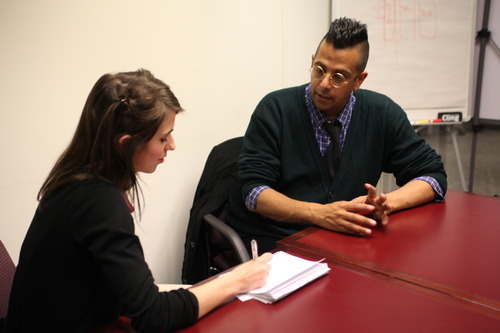
Tutorfair: Why do you love maths and science?
Simon: I think the question is, why wouldn’t you? Science is exciting! Just think about everything that’s been going on with the Big Bang at the moment. It’s fantastic. For maths, it’s a bit different. I originally did maths in order to do science, but after writing a lot about science, I began to see the beauty of maths. Take the number 26: it’s the only number between a squared number (25) and a cubed number (27). Despite the fact that there is an infinite quantity of numbers, we can prove that 26 is the only one. That’s really cool. In maths you can answer the questions, ‘How does that happen?’ and ‘How do we prove it?’
Why did you decide to study Physics at university?
I grew up during the space race so I was drawn to the physical sciences. I love learning about the universe.
Why do you think it’s important for children to learn maths and science?
Maths and science can bring tremendous joy! If they excite you, then they could become your career. But otherwise, maths and science have an impact on our lives – they help us understand how things work which is important. Even if your job has nothing to do with science, you will need to vote on issues like climate change or genetic engineering; you will need to decide whether to vaccinate your children and so on. So it’s important to understand the science and maths behind these concepts.
We find that children need tutoring the most for maths and science. Why do you think that is?
Maths is particularly not natural. Take my son, for instance: he learnt to talk and to walk and a lot of other things, all by himself. But counting did not come naturally; he had to be taught it. The idea of using a symbol to represent something is not natural for him. And maths becomes more and more abstract. Science is a bit different, but it has been argued that it’s also not so natural, making it more difficult to learn.
What would your words of wisdom be to kids who are currently struggling with maths or science?
They are such important subjects. You need to know the basis of maths and science to be an active citizen so stick at it and you’ll get there.
Can you tell us a bit more about the education projects you started – the Undergraduate Ambassadors Scheme (UAS) and the Enigma Project?
UAS provides university departments with the framework for a module which awards academic credit for undergraduates studying STEM subjects to work with teachers in local schools. They go into the schools once a week for about 10 weeks. Everyone is happy. The students love getting the experience and the teachers love having the support. The students are learning skills highly valued by employers, and the course is tough, so the academic credits are well deserved. This module runs in about 100 university departments now across the UK.
The Enigma project involves me lending my Enigma machine to Cambridge University so that they can take it around schools to run workshops with students about code breaking. It travels throughout the United Kingdom and abroad, visiting over 100 schools and organisations.
-----------------------------------------------------------------------------------------------------------
As you can see, Simon does some awesome work with STEM in education so it really was the perfect treat to have him visit us during National Science and Engineering Week.
Thank you Simon, we look forward to chatting to you again soon.
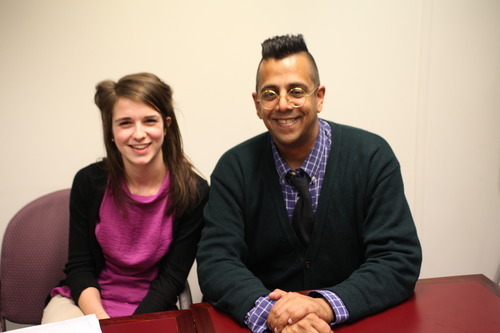
If you’d like some amazing scientists to come to your house try:



Alfredo C - Doing a PhD in how galaxies are formed. Recommended for Maths and Physics
Celine H - Just loves teaching science. Recommended for all sciences at GCSE
Stuart M - Microbiology and Immunology. Recommended for Biology, Chemistry and Maths
#simon singh#gcse maths#gcse science#undergraduate courses#engineering#technology#stem ambassador#the simpsons#physics#maths#biology#chemistry#inspirational tutors
0 notes
Text
Genetic Engineering Part 1: What are genes?

As part of National Science & Engineering Week, one of Tutorfair’s top Biology tutors, Frank I, explains how to get to grips with the GCSE Biology topic: genetic engineering. As Frank has a PhD in this specialism and has previously worked in the lab for Cancer Research, he certainly knows his stuff! His first blog post in this series on genetic engineering explains what genes actually are; not your standard Levi’s!
Genetic engineering. Thanks to decades of film and TV, it’s a term that conjures images of extreme deformity like Godzilla and Spiderman.Though the reality isn’t quite as crazy, the current and future impact of genetic engineering on each of us and and especially our children is, and will be, HUGE -- Godzilla huge.
As a species, human beings have been practising genetic engineering for thousands of years, though for most of that time we didn’t know it. From the moment the first tribe of hunter-gatherers settled down and realized that breeding the best wheat plants or the best cows together gave them even better wheat and better cows, human study into genetic engineering began. Today, we don’t just breed our crops and animals to get what we want, we pick genes from one species and pop them into another -- the ‘Frankenstein’ experiments we’ve all heard about.
Let’s back up. Before we can explain what genetic engineering is, I suppose we should get clear on just what a gene is. Genes, DNA, chromosomes, the nucleus -- we lump them all together in our heads and that’s fine, because they are just different ways of looking at the same thing. Chromosomes are just separate chunks of DNA, living in a bag inside the cell, called the nucleus. If we read along each chromosome, we can divide it up into segments called genes, and there are thousands of them in each and every cell!
So what is this DNA stuff that makes up our genes? Well, if you asked someone off the street they would probably say that DNA controls the cell and is responsible for our physical characteristics like eye colour or height. And they’d be right! But how exactly does DNA do this? DNA holds the instructions for what a cell should be doing. For example: the cells of a baby growing in a pregnant mother are instructed to divide rapidly; a muscle cell is instructed to contract; and a nerve cell is told to send an electrical impulse to the brain. Think of DNA as the boss of a busy factory (the cell) sitting high in an office shouting orders down to thousands of workers busy building and assembling a car. DNA doesn’t actually do any of the work -- the workers do! And each worker is different from all the other workers. Each worker is specialized to build one and only one part of the whole car, but each does its job very well. In our cell, those workers are proteins.
Proteins come in many different shapes and sizes: long and thin, spherical, ball-and-chain, and loads more. Like snowflakes, no two are identical. No two protein shapes are alike and no two jobs for our workers to do are alike. And each of us can make about 30,000 different shapes, each with a different job! Like our workers in the car factory where one is great at making the transmission while another is fantastic at making the steering wheel -- one protein (insulin) helps us control our blood sugar while another uses a blast of energy to spring forward and contract our muscles. Different cells like brain cells or heart cells use a different mix of protein workers to do their jobs.
Not only does the lazy DNA not do any of the actual work, DNA doesn’t even MAKE the workers. Little protein-making machines far, far from the nucleus do that job. DNA simply holds the information for HOW to make the proteins.
So how does this all actually work? Well, I’m all typed out. Shall we meet back here later for part 2?
If you have found this blog post helpful, you might also find Frank’s previous blog post explaining photosynthesis useful. Click here to view.
If you think you or your child needs some help with Biology and you fancy getting a tutor then please click here to view Frank’s personal profile on the Tutorfair website and book a lesson.
#genetic engineering gcse#what do genes do#gcse biology#biology gcse revision#greater london tutors#meet a tutor#private tutor#personal tutor#homework help#science tutor
1 note
·
View note
Text
Parent and tutor tips: How to help a child become comfortable with learning

By Mark Maclaine
Successful tutors, teachers and educational psychologists have a few techniques that are highly effective in helping students reach their full potential. Most of these center around the removal of stresses that are limiting those students. One technique involves helping learners to become comfortable with discomfort. When they can let go of the idea that there’s something ‘wrong’ with not knowing all the answers, learning becomes easier and hopefully a lot more fun.
During the last two years of his life, a young soviet psychologist called Lev Vygotsky developed a concept called the ‘zone of proximal development’ (ZPD).[1] This zone is essentially the range of skills that a student can perform with help, but cannot yet perform on their own. Vygotsky believed that a student learns by imitating a teacher, gaining, over time, the ability to do a task alone, thus moving that task out of the zone. It is the role of an educator to keep the ZPD constantly moving forward, encouraging the student to grow.[2]
Karl Rohnke, an American expert in experiential learning, later suggested that people react to situations in three different ways: comfort, stretch and panic. He developed a beautifully simple model that I’ve tried to show in this diagram:

In the ‘comfort’ zone, the learners are highly familiar with the situation. This includes everything they already know and tasks they can do almost without thinking. Students are comfortable here, feeling like they are in full control. But they are not learning.
At the other end of the scale, in the ‘panic’ zone the situation is highly stressful or can seem dangerous to the learner . In this zone there is often a perception that the skill required for success is so far out of reach that it’s not even worth trying. Students in this zone can be overwhelmed, feeling like they have no control, and may ‘shut down’ entirely.
The trick to growth is to be somewhere in the middle, where the student is slightly uncomfortable but still learning.
Drawing the diagram above for students helps them to realise that there’s nothing wrong with feeling uncomfortable when learning: like Vygotsky’s ZPD, the best thing about the ‘stretch’ zone is that it’s constantly moving as we learn. This helps students who feel ‘I’m never really getting anywhere’. When students can see that they are getting somewhere (the zone is moving after all!), stress, that would otherwise inhibit learning, is reduced.That said, it’s important for everyone to find a balance between stretching yourself and taking care of yourself in your comfort zone.
The diagram also helps pupils to recognise when they’ve been pushed into the panic zone. A student who knows it’s normal to feel overwhelmed at times is much more likely to speak up about it, and to seek help; one of the hardest jobs for any teacher or tutor is knowing who’s ‘got it’ and who hasn’t. A child who feels shame may find it hard to approach the teacher, but if your students are comfortable approaching you with concerns you can solve problems early on. The same thing goes for a parent. Opening up this dialogue with children helps them feel comfortable about coming to you if they ever feel overwhelmed in the future.
This week: see what activities you can undertake to place yourself in your stretch zone. Then find ways to help your children or students to do the same.
Fancy getting a tutor to help stretch your child's learning? Have a look at the Tutorfair website and take your pick. Here's a small selection:



Oliver G - Calm, patient tutor who likes to make learning engaging. Subjects include English, History and German
Helen J - Experienced and enthusiastic tutor who is a qualified teacher. Subjects include French and German
Allan G - Experienced tutor, motivator and life coach. Subjects include Maths, Physics and Computing
-------------------------------------------------------------------------------------------
1] Vygotsky lived from 1896 to 1934. His work had largely remained unknown until the 1970s, when it eventually became a central component of the new theories in developmental and educational psychology.
[2] His concept led to the idea of scaffolding, Wood et al. (1976), in which a student should be given regular support and guidance in learning until they are able to undertake these tasks on their own. This is also known as guided or cooperative learning.
#child development#child psychology#how do children learn and develop#intellectual development in children#child development theories#effective learning#teaching strategies#teaching methods#best teaching methods#learning styles#effective teaching#student learning
1 note
·
View note
Text
Stephanie W: Maths and Physics tutor in London

Stephanie W is an engaging Oxford physics graduate and Imperial PhD student who tutors maths, physics and Oxbridge admissions. On top of that, Stephanie is also a professional squash player; this lady is certainly talented!
Why do you love tutoring?
Partly, it’s an excuse for me to revisit interesting maths and physics concepts that I don’t meet on a day-to-day basis. And it is very rewarding watching my students improve. Last year, both the students who I guided through Oxford entrance received offers-- a thrilling outcome!
Who inspired you in education?
Lots of people. I had a great physics teacher at school, an excellent physics tutor at Oxford and I have two brilliant supervisors at Imperial.
What else do you get up to besides tutoring?
Mainly squash. I am trying to hit the top 100 in the world by the end of this year.

If you had a superpower what would it be?
Getting by on very little sleep. There aren’t enough hours in the day for all the things I want to get up to!
What advice would you give to a parent on how to find a tutor?
Tutoring is a very personal thing, so make sure you find a good fit for your child. Also think about the bigger picture. Will the tutor inspire your child and be a good role model?
Want to meet Stephanie? See below to view her short video:
Subjects taught by Stephanie:
Maths - A-Level
Physics - A-Level
Maths Aptitude Test - MAT
Oxbridge Admissions
Physics Aptitude Test - PAT
UKMT Challenge
If you or your child needs help with maths or physics then please click here to visit Stephanie’s profile page on the Tutorfair website and book a lesson.
Photograph from commons.wikimedia.org CC-by
#home tutoring#greater london tutors#meet a tutor#private tutor#personal tutor#greater london#homework help#science tutor#maths tutor#maths revision#a level science revision#science and maths tutor#a level physics tutor#university entrance help#oxbridge admissions#gcse science tutor
0 notes